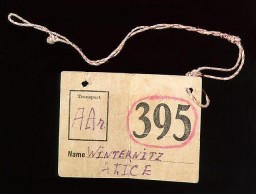<< Previous | Displaying results 1601-1610 of 6707 for "" | Next >>
-
Handkerchief carried by a young Hungarian Jewish girl on the Kasztner train
ArtifactA red and yellow floral handkerchief belonging to Judit Gondos that she took with her when she left Budapest on the Kasztner rescue train.

-
Romani (Gypsy) musician's violin used in a prewar musical band
ArtifactViolin owned by Rita Prigmore and originally used by her father, who played with his four brothers in a band in Germany before World War II. Rita and her family were members of the Sinti group of Roma (Gypsies). She and her twin sister Rolanda were born in 1943. Rolanda died as a result of medical experiments on twins in the clinic where they were born. Rita and her mother survived the war and moved to the United States, before returning to Germany to run a Sinti human rights organization that sought to…
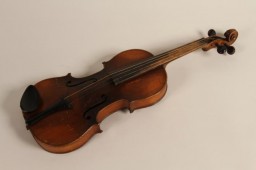
-
Small hooked rug used in the wagon of a Romani (Gypsy) family
ArtifactThis small patterned hooked rug was used as a shoe mat in the wagon of Rita Prigmore and her family when she was a child in Wurzberg, Germany, after World War II. Rita and her family were members of the Sinti group of Roma (Gypsies). She and her twin sister Rolanda were born in 1943. Rolanda died as a result of medical experiments on twins in the clinic where they were born. Rita was returned to her family in 1944. She and her mother survived the war and moved to the United States, before returning to…
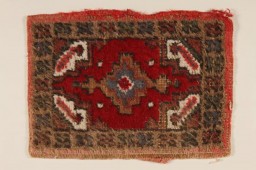
-
Blacksmith's bellows used in a Romani (Gypsy) encampment
ArtifactThese blacksmith's bellows were used by Romani (Gypsy) artisan Juri Cervenuak in Trebisov, Slovakia, in 1939. Many Roma traditionally worked as craftsmen and were blacksmiths, cobblers, tinsmiths, horse dealers, and toolmakers.
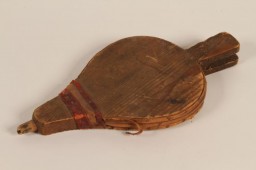
-
1936 Berlin Olympics torch holder
ArtifactThis Olympic torch holder was used during the 1936 Berlin Olympics. It is engraved with the 1936 Olympics torch relay route from Olympia, Greece, to Berlin, Germany.
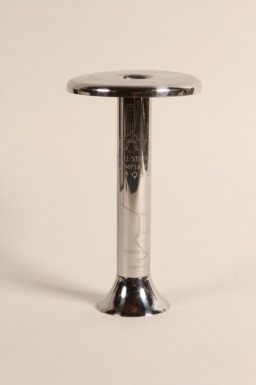
-
1963 postage stamp commemorating Treblinka
ArtifactIn 1963, the German Democratic Republic (DDR) issued this postage stamp to commemorate the Treblinka killing center. This was the first stamp of a series issued annually by the DDR under the name Mahn- und Gedensksatte (Remembrance and Memorial Center) in remembrance and commemoration.
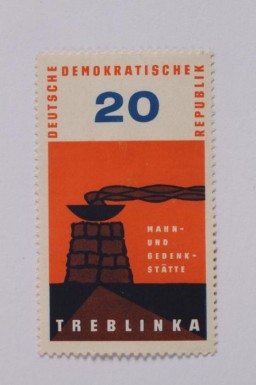
-
Krakow ghetto armband
ArtifactIn December 1939, German authorities required Jews residing in the Generalgouvernement (which included Krakow) to wear white armbands with blue Stars of David for purposes of identification. The armband pictured here was donated to the United States Holocaust Memorial Museum in 2001 by Akiva Kohane.
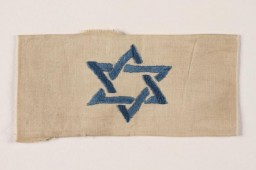
-
Nazi banner
ArtifactNazi banner with a swastika. The swastika became the most recognizable symbol of Nazi propaganda, appearing on the Nazi flag, election posters, arm bands, medallions, and badges for military and other organizations.

-
Drawing of shoes by a Jewish teenager in hiding
ArtifactJewish teenager Ava Hegedish drew this poignant picture of her mother's well-worn shoes while in hiding. It was drawn while Ava was in hiding at a farm near Belgrade, Yugoslavia (now Serbia), between 1941 and 1944. Once Nazi Germany and its Axis partners partitioned Yugoslavia and Belgrade fell under German control, Ava’s father thought the family’s best chance of survival was to separate and go into hiding. Ava ended up at a farm with some extended-family Serbian relatives. Because she…
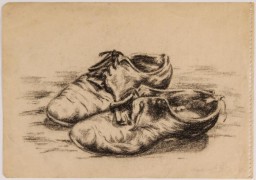
-
Alice (Lisl) Winternitz's luggage tag
ArtifactThis paper tag identified bedding belonging to Alice (Lisl) Winternitz when she was deported from Prague, Czechoslovakia, to the Theresienstadt ghetto in June 1942.
